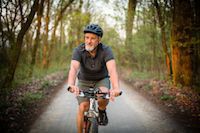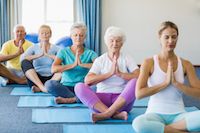What is physical activity?

You may have heard that exercise and physical activity are good for you. Regular physical activity can help keep you healthy and active as you age. It can also help with many long-term health issues. And you can even enjoy it, especially with family and friends.
Why is physical activity good for me?
Being active has many benefits. When you are physically active and exercise regularly, you are decreasing your risk for illnesses like:

- Heart disease
- Stroke
- Blood pressure
- High cholesterol
- Diabetes
- Obesity
- Breast cancer
- Colon cancer
- Anxiety
- Depression
- Take the stairs instead of an elevator
- Garden
- Mow the lawn
- Walk your dog
- Swimming
- Hiking
- Running and jogging
- Bicycling
- Yoga
- Dancing
- Lifting weights
- Resistance bands
If you already have any of these, physical activity and exercise can help you control your illness. Being active can also help you feel better and sleep better.
What are the different types of physical activity?
The three major kinds of exercise are aerobic exercise, strengthening, and flexibility training. Aerobic activity raises your heart rate and makes you breathe faster. Walking/jogging and swimming are good examples. Lifting weights is an example of strengthening. Flexibility training includes stretching or yoga. This is especially important for older people. You should try to do all three types of exercise every week.
How much physical activity should I try to do?
You don't need a gym membership to exercise--you can do it in your home or neighborhood. Adults need at least 2 hours and 30 minutes (150 minutes) of moderate activity every week and two days a week of strength training. That may sound like a lot but don't worry! You can break that time up however you want, as long as you spend more than 10 minutes at a time with each activity. If you are new to exercise, remember to start slowly and work your way up. You should also spend less time sitting every day! Too much time sitting increases your risk of health problems. Having breaks every hour to walk or go up the stairs for a few minutes is helpful.
What can I do to be physically active?
What can I do to exercise?

Here are some aerobic activities that will increase your heart rate
Here are ways to strengthen your muscles
Is exercise safe for me?
If you have not been active for a very long time, you might wat to talk with your healthcare professional about how to start. If you get short of breath or have chest pain at any time, stop exercising and contact your healthcare professional.
Print Version
References/Resources
References
Blumenthal JA et al. Is exercise a viable treatment for depression? ACSMs Health Fit J. 2012;16(4):14-21.
Centers for Disease Control and Prevention. 2008 Physical Activity Guidelines for Americans: Fact Sheet for Health Professionals on Physical Activity Guidelines for Adults. Retrieved from https://www.cdc.gov/physicalactivity/downloads/pa_fact_sheet_adults.pdf.
Lynch BM et al. Physical activity and breast cancer prevention. Recent Results in Cancer Research. 2010;13-42.
Naci H, Ioannidis JPA. Comparative effectiveness of of exercise and drug interventions on mortality outcomes: metaepidemiological study. BMJ. 2013;49(21):1414-1422.
National Heart, Blood, and Lung Institute. (2016). Physical Activity and Your Heart. Retrieved from https://www.nhlbi.nih.gov/health/health-topics/topics/phys.
Patel AV et al. Leisure time spent sitting in relation to total mortality in a prospective cohort of US adults. Am J Epidemiol. 2010;172(4):419-429.
Sharma M et al. A systemic review of yoga interventions as integrative treatment in breast cancer. J Cancer Res Clin Oncol. 2016;142(12):2523-2540. Youngstedt SD. Effects of exercise on sleep. Clin Sports Med. 2005;24(2):355-365.
Patient Education Materials
- Acupuncture
- ADHD
- Allergic Rhinitis
- Anxiety
- Aromatherapy
- Asthma
- Autism
- Back Pain
- Biofeedback Therapy/Training
- Breathing Techniques
- Cancer Symptoms
- Chiropractic
- Constipation
- Depression
- Diabetes
- Dyslipidemia
- Eczema
- Elimination Diet
- Fibromyalgia
- GERD
- Headache
- Healthy Diet
- Healthy Weight / Obesity
- Heart Disease
- High Blood Pressure
- Inflammatory Bowel Disease
- Insomnia
- Irritable Bowel Syndrome (IBS)
- Massage Therapy
- Meditation
- Menopause
- Menstrual Disorders
- Osteoarthritis
- Probiotics
- Progressive Muscle Relaxation
- Rheumatoid Arthritis
- Supplements
- Tai Chi
- Yoga